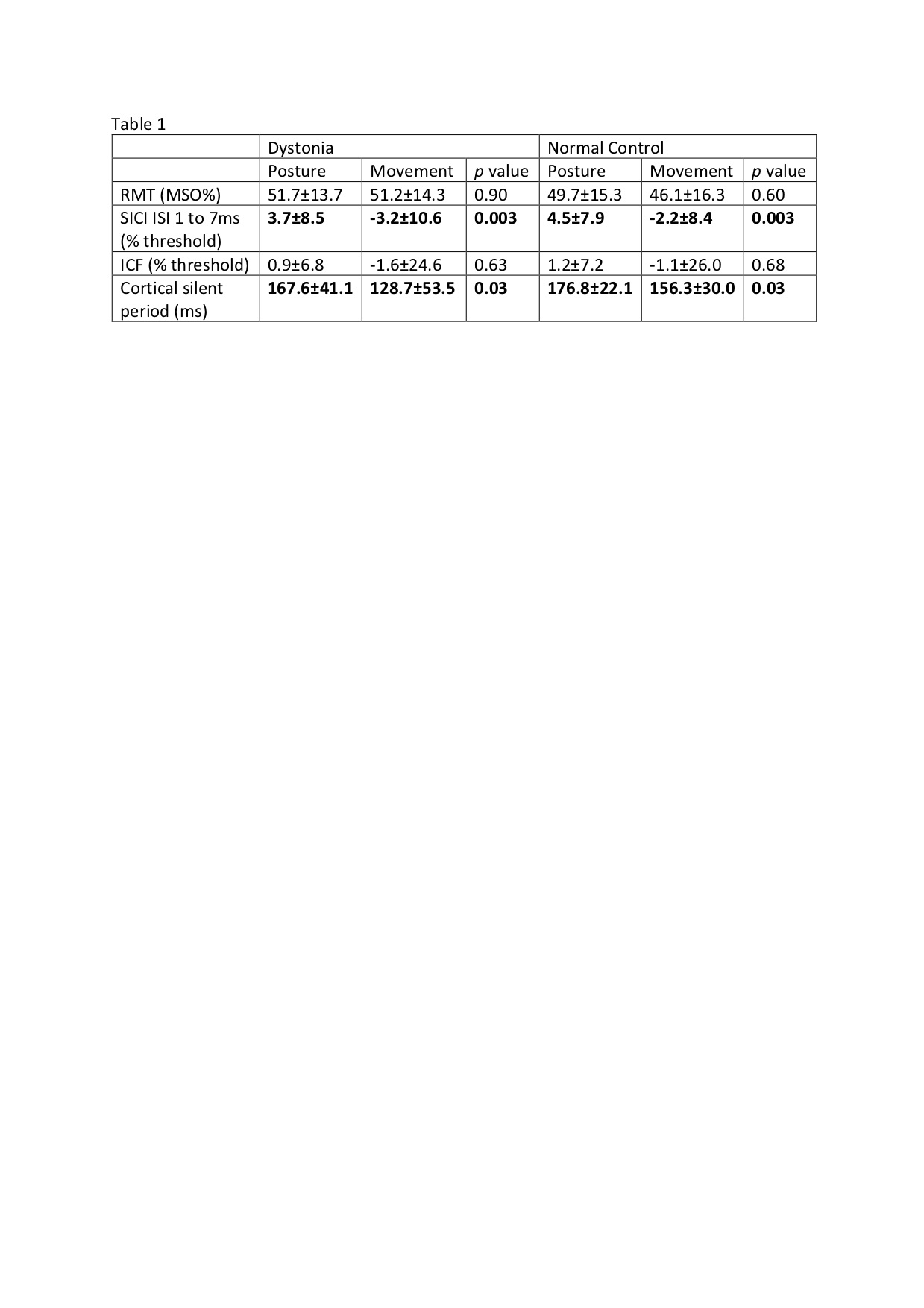Session Information
Date: Tuesday, September 24, 2019
Session Title: Neurophysiology
Session Time: 1:45pm-3:15pm
Location: Les Muses Terrace, Level 3
Objective: To investigate cortical excitability during movement compared with postural control task in healthy and focal dystonia subjects.
Background: Focal dystonia is a movement disorder associated with reduced cortical excitability and surround inhibition, thought to mediate abnormal co-contraction and overflow during performance of a motor task. Motor task performance can be divided into maintenance of posture control and movement. Separate neuronal populations within the primary motor cortex mediate for postural and movement control in the healthy primate1. We explore whether there is a difference in cortical excitability during movement compared to postural control task in focal dystonia subjects.
Method: Short interval cortical inhibition (SICI), resting motor threshold (RMT) and cortical silent period (CSP) were measured following transcranial magnetic stimulation over the primary motor cortex, recording over the contralateral resting abductor pollicis brevis muscle (APB) of the pronated hand. We used threshold tracking technique for SICI 2, during performance of a postural control task (constant extension of ipsilateral extensor indicis (EI)) and movement control task (activation of EI at 1Hz). Studies were undertaken on 18 healthy controls and 14 focal dystonia patients (cervical dystonia (CD) =7; Writer’s cramp (WC)=7). Two-way ANCOVA tested for interaction of motor task and group, correcting for age, using SPSS 24 (IBM). Pairwise comparison used one-way ANCOVA with Bonferroni adjustment, examined for difference between and within groups.
Results: There was a difference in the SICI and CSP between the motor task on pairwise comparison, and during movement, the adjusted mean SICI (p=0.003) and CSP (p=0.03) was lower than postural task in both groups. (Table 1) The RMT was lower in normal subjects than dystonia patients (p=0.03). The adjusted means of SICI, ICF or CSP was not different between groups. There was no significant interaction between groups and motor task for RMT, SICI (ISI 1-7ms), ICF or CSP. This remained unchanged when focal dystonia group was subdivided into CD and WC.
Conclusion: Cortical excitability in both normal controls and focal dystonia subjects was greater during movement control task than postural control task, but did not differ between groups during motor tasks. This suggests motor cortical GABAergic synaptic activity during movement control is preserved in focal dystonia patients.
References: 1. Kurtzer, I., Herter, T. M., & Scott, S. H. (2005). Random change in cortical load representation suggests distinct control of posture and movement. Nature neuroscience, 8(4), 498. 2. Vucic, S., Howells, J., Trevillion, L., & Kiernan, M. C. (2006). Assessment of cortical excitability using threshold tracking techniques. Muscle & Nerve, 33(4), 477-486.
To cite this abstract in AMA style:
FCF. Chang, S. Kim, P. Menon, N. Geevasinga, N. Mahant, S. Babu, S. Vucic, V. Fung. Cortical excitability in focal dystonia patients using threshold tracking technique [abstract]. Mov Disord. 2019; 34 (suppl 2). https://www.mdsabstracts.org/abstract/cortical-excitability-in-focal-dystonia-patients-using-threshold-tracking-technique/. Accessed December 28, 2025.« Back to 2019 International Congress
MDS Abstracts - https://www.mdsabstracts.org/abstract/cortical-excitability-in-focal-dystonia-patients-using-threshold-tracking-technique/

